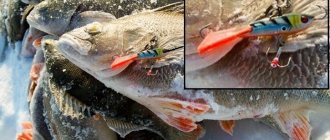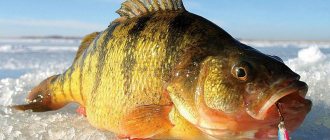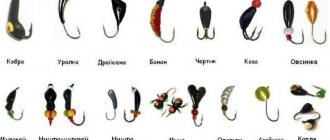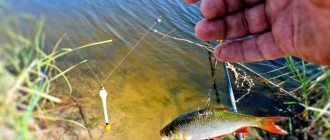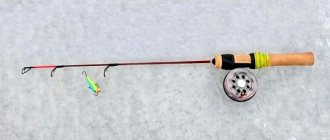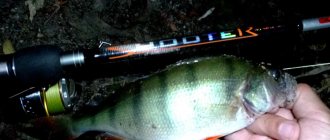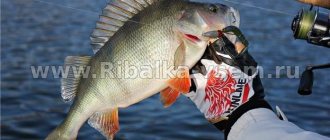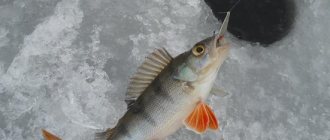Among the variety of winter perch lures, the fiddlehead is deservedly popular. This small-sized artificial fish (fry) is often superior in its catchability to reelless jigs, balancers and bottom spoons. In addition to its catchability, the popularity of this bait is also explained by the ability to make it yourself.
What is a bully
Malek pyzdrik is an artificial, mainly perch winter bait, similar to small fish.
The bait consists of the following parts:
- The body is cone-shaped with a large head and a narrowed rear part. Body length can be from 10-15 to 25-40 mm. It is made from special threads coated with a layer of UV varnish, transparent silicone or epoxy resin.
- A movable tail-panicle, consisting of many fibers, a bright artificial feather, and a piece of fur. The length of the tail is usually slightly longer than that of the body. The color of the tail varies from plain white to bright red, acid yellow, and green.
- Single hook No. 8-10 dark yellow or black with a long shank or jig head weighing 1.5-3 g.
The majority of both homemade and factory models have two small eyes in the head part, imitation of small scales.
Advantages and disadvantages
The main advantages of such artificial fry over other perch baits are:
- Maximum resemblance to fry and amphipod crustacean. It imitates well not only small fish, but also the crustacean mormysh.
- Tail mobility – the tail, consisting of many fibers, creates vibrations that attract perch when moving the bait.
- Possibility to use without an animal bait - unlike large jigs, baits are not used when fishing for such artificial fry.
- High grip – the slightly bent downward ring and the point-down hook allow you to hook a perch even with the weakest bite.
The disadvantages of such bait include its relative fragility - soft baits that have been in the mouth of a large perch or pike several times can quickly become unusable.
We recommend reading: The best lures for asp
Varieties of pussies
All these baits, depending on the installation method and weight, come in two main types:
- Suspended (lightweight) – small-sized artificial fry that do not have their own large load. Their weight is determined by the size of the hook and the thickness of the wire from which it is made.
- Weighted (independent) - silicone fry, in which instead of a hook a spherical jig head is built into the body.
The first type is used as an additional bait along with larger and heavier spoons and spinners. Weighted models are most often used as the main bait. They are tied to the end of the main fishing line, and not to a separate upper leash like their lightweight counterparts.
What is a pyzdrik bait and what does it consist of?
A pyzdrik is a cross between a fly, a jig and a silicone bait. In its classic form, it is based on a single hook, on which is located a body made of light polymer material. It can be assumed that the fish perceives such an object as something between an amphipod and a fry.
Pyzdriks are used as additional bait. They are usually placed on the same rig as a spinner or balancer. The bait itself weighs too little, because of this, as a rule, it is problematic to even lower it to the required depth if it is the only bait in the rig. Acting as an additional bait, it reveals its full potential.
Pyzdrik is a logical continuation of the development of the fry fly . At the same time, it often turns out to be more catchy. Amateur fishermen in different parts of the country and the world have been making similar baits for decades. But it is in recent years that pizdriki have gained great popularity.
At first, many fishermen who learned about this bait began to make them for themselves, then factory-made models appeared on store shelves.
As a result, today every fisherman has a choice - to make them himself or purchase ready-made ones. Reference! Pyzdriki have only recently entered into widespread fishing practice, so the full potential of these lures remains undiscovered. Already today, many fishermen successfully catch perch and other fish with them. But more and more new options for using these baits continue to appear. For example, pyzdrikov can be used instead of hooks when collecting bulldozers. Each fisherman can experiment, trying different options for using them to find something interesting for himself.
An example of a pussy
How to make a perch bait with your own hands
Self-production consists of a preparatory stage and direct installation of the pad.
Tools and materials
To make the simplest silicone fish of this type, you need the following tools:
- Pliers;
- Sharp nail scissors;
- Knife;
- Tweezers.
The following materials are needed for such a homemade product:
- Vibrating tail or twister made of transparent inedible silicone;
- Sewing thread;
- Silicone cambric;
- Red beads;
- Hook for tying flies No. 8-10;
- Super glue.
To melt the twister, you can use a transparent glass container with a volume of 250-300 ml. Melt silicone in a regular microwave oven.
Manufacturing process
A simple homemade pizdrika is made as follows:
- Using pliers, the eye of the hook is bent at an angle of 25-30 0 towards the tip;
- A piece 5-6 mm long is cut from the silicone cambric, and two red beads are placed on its ends.
- A cambric with beads is fixed with glue across the shank of the hook 4-5 mm from the ring;
- Starting from the ring, sewing thread is wound onto the forend, leaving the ends 20-25 mm long. By winding 10-15 threads in this way, you get a very voluminous and movable tail.
- The twister is cut into small pieces, which are poured into a small glass and placed in the microwave for 60-90 seconds;
- As the silicone melts, heating in the microwave is periodically paused and the resulting viscous mass is stirred;
- As soon as the silicone completely melts and takes on the appearance of a homogeneous viscous mass, the glass is removed from the microwave;
- The hook with the thread wound is lowered in a ring into the molten silicone and, after making several rotational movements, it is quickly removed;
- Before the silicone has cooled down, use your fingers to give the body of the bait the desired shape;
- After the silicone has cooled, the body is finally leveled using a sharp knife or blade.
Recommended reading: How to catch an asp using a spinning rod
Instead of threads, the ponytail is often made from brightly colored feathers or pieces of faux fur.
Testing the finished bait
The made bait is tied to the tackle with a nod and tested in an aquarium, barrel or bathtub.
A properly made silicone fish will have constant and unstuck movements and high mobility of the tail fibers during various types of play. Very often, during the test, the little thing falls on its side and its tail sticks together. This behavior of the silicone fry can be caused by a shift in the center of gravity of its body and the use of a very wet material for the tail. The first defect can be corrected by removing excess areas of material. If the tail of the plug sticks together, you will have to completely redo it or make a new one to replace the defective one.
Making a pyzdrik with your own hands
It is unknown why this bait received such a dubious name. Probably the reason for this was precisely her extremely tiny, very insignificant size and active, active play. In any case, this bait has other names - lapwing or gavrik.
You can make a pie as follows:
- The fishing hook is fixed in a vice, after which the mounting thread is wound around it;
- The melted fishing line needs to be tied with a mounting thread on both sides, which will act as a kind of “eye”;
- You need to create a stylized tail from the “flash”, and then try to attach it as carefully and at the same time firmly to the hook using the same mounting thread;
- Wrap the tail several times around the hook and re-fix it with thread;
- Apply varnish made of liquid polymers and acrylic resins to the hook;
- Try to achieve a thickening effect on the “head” of the resulting bait.
In order to improve the resulting model, you can equip it with a special leash that is resistant to the bites of such predatory fish as pike. Many fishermen, along with the bait on spinners and various types of balancers, also install nods; it is in this form of options that the ultimate fishing outcome will be maximum.
There are two ways to tie a lure to a spoon: directly above the main bait, or at the very end of the fishing line. In cases where the bait is located above the main bait, then it must be tied to a special outlet. So that he looks up, not down, in this case he will be able to protect himself as completely as possible from tangling the fishing line.
The pydzrik has proven itself most well when working in tandem with a spinner. When a predatory fish sees two objects at once - a large and a small one, which both can become its victims, its instinct of competition is instantly triggered, and it rushes headlong after easy prey, wanting to get ahead of a possible potential hunter who is lurking somewhere nearby and covets for her prey.
Preparing for fishing
Probably the secret of the fish's catchability lies in its similarity to the movements of a fry in the water. The appropriate tackle and fishing technique will help achieve such realism.
Types of bait installation
When fishing with pyzdrik, the following types of installation with other artificial baits are used:
- “Finnish rig” - the hanging hook is removed from the bottom spoon, a swivel with a 20-30 centimeter line leash is attached to its ring, on which a cap is attached;
- Tandem with a spoon or spinner - a heavy vertical spoon is tied to the end of the main line, and a loop is made 20-30 cm from it, to which a 10-15 cm leash with a cap is attached;
- “Balda” rig – this installation consists of a fishing line loop 30-40 cm long with a sliding 10-15 gram sinker, on both sides of which there are two pins;
- Bottom rig (tandem of 2 pins) - a pear-shaped sinker is tied to the end of the main line, and two loops are made above it, to which leashes with pins are tied. The distance between the sinker and the first leash, between adjacent upper leashes is on average from 15 to 20-25 cm.
Pyzdrikov are often used as the main bait, combined with small twisters no more than 50 mm long.
Recommended reading: How to catch carp on a feeder
Gear selection
Depending on the method of installation, the following gear is used for fishing with pyzdrik:
- When fishing with pyzdrika as the main bait - a light balalaika fishing rod, a line with a cross-section of 0.12 mm, a hard lavsan nod 10-12 cm long;
- When fishing in “tandem” with a spoon or spinner - a carbon fiber rod 40-60 cm long, an inertial reel with a diameter of 4-5 cm, a fishing line 0.12-0.14 mm thick, a nod made from a piece of nipple rubber;
Metal leashes are not used when fishing with bullfish. With them, the performance of the bait and the number of bites deteriorate. The fishing line is made from fishing line of the same thickness as the main one.
Tackle and floats
To catch perch with fry, you don’t need any special rod; a regular Bolognese telescopic rod with a fast action, 4-5 m long, is quite enough. For it you need to choose an inertia-free reel with a size of no more than 1500 with a gear ratio of 5.5: 1-6.5 :1. A high speed of rotation is preferable, since you have to fish quickly in order to catch as many perches as possible from the moving school.
I use the main line with a diameter of 0.18-0.2 mm, and the leader line with a diameter of 0.15-0.16 mm. The monofilament must be of high quality and have good shock-absorbing properties, which is important for long-distance casting of the bait. When fishing in windy weather I use a sinking line; hook - No. 5-8. I try to make the leash 40-50 cm long, because a long leash allows you to better play along with the bait.
Sometimes it happens that while fishing, part of the fry in the eland turns upside down with its belly, and live, mobile fry is often missing. In this case, by moving the tip of the rod you can drag or tug the dead fry baited on the hook, and on a long leash it either floats higher or slowly falls down. This provokes the perch, and it grabs the bait.
For short casts, a float with a load capacity of 5-6 g is used. For casts further away, a float with a load capacity of 7-10 g or more may be required.
Since perch fishing most often occurs in areas with minimal current, the float should be shaped like a thick drop or pear. Floats made of balsa or foam are suitable. When fishing in calm weather, a float with a short keel and one lower attachment point to the fishing line is used. But in windy weather, when the line floats heavily and drowns such a float, you have to use a float with two attachment points: one on the keel below, the other on the body near the antenna. In this case, it is advisable to use a keel of medium length and weighted (metal).
Read! Catching ruff with a float rod
Tactics and techniques for catching perch with a puffer
They can be caught using the baitfish throughout the ice fishing season. In terms of first ice and last ice, shallow places in the coastal zone are most promising. In the dead of winter, dumps of pits and pools, and deep-sea snags are more catchy.
Fishing for such silicone fish is practiced by the following types of games:
- Sharp swings - this type of play is used for Finnish rigs and tandems with a heavy boom. Its essence consists of sharp and short wrist strokes with 2-5 second pauses. With a weak bite or uncertain bites, make more sweeping and smooth strokes without pauses. This technique is called "teasing".
- Slow rise with smooth oscillations - when using this bait together with small twisters, the entire equipment is lifted from the bottom when retrieving, giving it low-frequency and smooth oscillations. At the same time, pauses are made every 10-15 cm of rise, the duration of which is selected taking into account the activity of the fish.
- Reverse retrieving without hesitation - with this playing technique, the bait is raised above the bottom by 50-60 cm. After this, slowly, with short pauses and without hesitation, it is lowered back.
Combinations of these retrieves are also effective - slow retrieve with smooth oscillations followed by lowering to the bottom, smooth strokes.
Night fishing with live bait
At night, pike perch can be caught both from the shore and from a boat. For boat fishing, they use mugs with fireflies placed on the masts for better visibility and small pieces of reflective material wrapped around them. For fishing from the shore, spinning rods up to 3 meters long are used.
Just like when fishing for pike perch at night with a spinning rod, fanged ones are looked for in places with coastal holes, dumps, irrigation areas bordering the depths.
When fishing, you should remember that you cannot take fish the size of the fishing standard established by law (40 cm). By catching a predator less than this limit, the fisherman causes enormous harm to the pike perch population and risks being seriously punished by environmental authorities.

